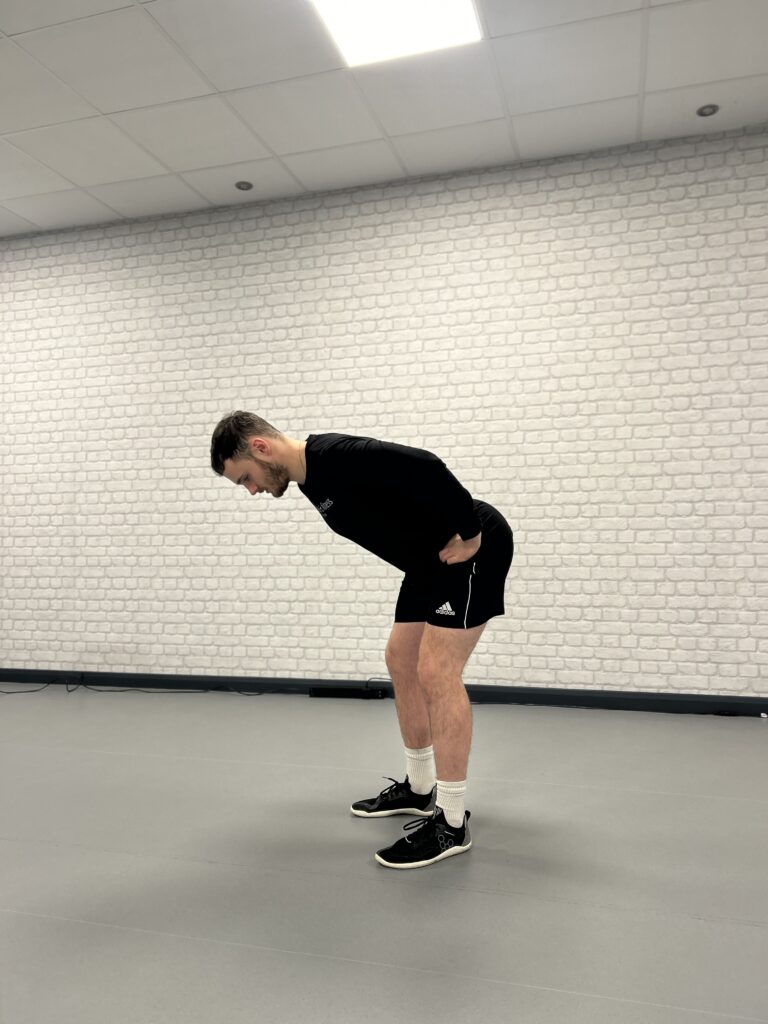Understanding Posterior Pelvic Tilt
Posterior pelvic tilt is when the front of the pelvis rises, and the back of the pelvis drops. This causes the pelvis to rotate upwards and the tailbone to tuck under. Consequently, the hip and knee joints are usually over-extended to compensate.
This pelvic misalignment can cause a range of issues affecting both daily life and physical activities. The position of the pelvis matters when referring to spinal alignment and lower back health. Increased stress on the lumbar spine, hip discomfort, and gait (walking pattern) alterations are just a few consequences of posterior pelvic tilt.
Causes
Most problems associated with posterior pelvic tilt stem from chronic postural misuse such as sitting in a slouched position. Tightness in the abdominal region and/or hamstrings pull the hips down into posterior rotation, which consequently compresses the torso and chest down. This can cause a more vertically stacked spine where the vertebrae (bones in spine) are stacked on top of each other.
It takes a significant amount of tension in the core and hamstrings to cause posterior pelvic tilt. Genetics can play a part in its development, however, poor mechanics during siting and standing will exacerbate a person’s tight hamstrings and core. Additionally, poor lifting mechanics in the gym can further encourage the pelvis into a posteriorly tilted position.
Impact on Health
- Posture – Posterior pelvic tilt will cause a person to adopt a “slouch” position when standing and sitting. This not only influences physical health but could impact self-esteem aswell.
- Altered Gait (walking pattern) – The pelvis is involved in our gait (walking). If its movement is restricted, a person may have less efficient walking mechanics.
- Tightness in Abdominals and Hamstrings – As discussed, a person may feel tight or “compressed” in these areas. Tightness in the abdominals could even affect a person’s breathing and ability to relax as the lungs movements are restricted. Tightness in the hamstrings will likely increase risk of hamstring injuries.
- Lower Back Pain – Our back and spine is designed to curve. As discussed, posterior pelvic tilt causes a stacked vertebrae creating a “rod” like appearance. This restricts its movement which can cause lots of stiffness in the area. The spine’s movement will also be restricted, and it may not be able to deal with the demands of daily life without getting injured.
- Hip and Knee Discomfort – Prolonged posterior pelvic tilt will likely impact the hips and the knees. Posterior pelvic tilt causes the hips and knees to be over extended, which can increase risk of injury and cause discomfort.
Exercises To Help!
Treatment for posterior pelvic tilt should take a multifaceted approach. Not one stretch or exercise will solve this issue. General strength training with proper form will be a great start for someone with posterior pelvic tilt. However, most importantly, you must make small adjustments to the way you sit and stand, as this is what’s worsening your posterior pelvic tilt.
If you think your form is wrong or you don’t know where to start with strength training, it’s a great idea to speak to a personal trainer. Additionally, if you can’t work out what you need to change about the way you stand and sit, speak to a trained therapist.
Some more specific exercises that may help relieve tension or build muscle in the right areas are shown below:
1. Hip Hinge
Everyone’s tried to reach down and touch their toes before. There’s a far better way to lengthen out the hamstrings which does not involve reaching to touch the floor, and this is called the hip hinge.
When doing this, try to focus and think about “making your bum big” and sending you bum back without flexing your knees. Play around with it and you should find a good position in which you feel an intense stretch along the hamstrings (back of thighs). Once found, hold this position for 1 minute and perform exaggerated breaths. To make this even more intense, add a kettlebell.


2. Leg Raises
Traditional “core” exercises will have a person “crunching” forward to work the abs. Although you are getting a good squeeze in the rectus abdominus (ab muscles), for a person with posterior pelvic tilt this is going to reinforce the torso down, tailbone tucked body position that they find themselves in. Something such as a leg raise is a good exercise for the core muscles as they are lengthening under tension.
During this movement the leg muscles are going to be desperate to take over the movement. Therefore, it’s really important that you engage the muscles around your midsection and take the movement as slow as you can. This will help to build “strength at length” and stability around the core. Doing this movement laying down on your back will make it easier, while doing this while hanging off a bar will make it harder.

Book in for a postural assessment with tfd therapy to get an understanding of how your pelvic alignment could be affecting your daily movements and how to help correct this.

